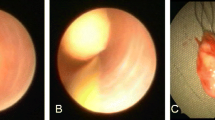Abstract
Excision has been the treatment of choice in benign non-tumorous obstructive disorders of the major salivary glands, when symptoms persisted in spite of conservative measures. Unfortunately surgical resection has been associated with a relatively high rate of adverse effects. To meet the need for a less invasive treatment modality for benign obstructive non-tumorous disorders (i.e., salivary stones or stenosis), sialendoscopy has been developed and implemented in several countries here among Denmark. This study is a 13-year retrospective registry-based study using The Danish National Patient Register. ICD-10 codes used for non-tumorous obstructive disease of the salivary glands were identified and used to extract patients potentially eligible for sialendoscopy in order to compare sialendoscopic surgery and extirpations of salivary glands. In 2012 sialendoscopy accounted for almost 20 % of all surgical interventions on the major salivary glands due to benign non-tumorous disease. Nationally and regionally the total number of resected major salivary glands due to benign obstructive disease also decreased significantly during the study period. A positive outcome, like the ones described here, will inspire further development and dissemination of gland preserving techniques, to great benefit for the patients.




Similar content being viewed by others
References
Springborg LK, Møller MN (2013) Submandibular gland excision: long-term clinical outcome in 139 patients operated in a single institution. Eur Arch Otorhinolaryngol 270:1441–1446. doi:10.1007/s00405-012-2175-4
Hald J, Andreassen UK (1994) Submandibular gland excision: short- and long-term complications. ORL 56:87–91
Dabirmoghaddam P, Hosseinzadehnik R (2013) Interventional sialendoscopy with endoscopic sialolith removal without fragmentation. Indian J Otolaryngol Head Neck Surg 65:111–115. doi:10.1007/s12070-012-0573-y
Nahlieli O (2009) Endoscopic surgery of the salivary glands. Alpha Omegan 102:55–60
Gillespie MB, O’Connell BP, Rawl JW, et al (2014) Clinical and quality-of-life outcomes following gland-preserving surgery for chronic sialadenitis. Laryngoscope. doi:10.1002/lary.25062 (Epub ahead of print)
Danquart J, Wagner N, Arndal H, Homøe P (2011) Sialoendoscopy for diagnosis and treatment of non-neoplastic obstruction in the salivary glands. Dan Med Bul 58:A4232
Gundlach P, Hopf J, Linnarz M (1994) Introduction of a new diagnostic procedure: salivary duct endoscopy (sialendoscopy) clinical evaluation of sialendoscopy, sialography, and X-ray imaging. Endosc Surg Allied Technol 2:294–296
Rasmussen ER, Arndal H, Rasmussen SH, Wagner N (2012) Steady progress seen in endoscopic surgery on major salivary glands. Dan Med J 59:A4525
Koch M, Iro H, Künzel J et al (2012) Diagnosis and gland-preserving minimally invasive therapy for Wharton’s duct stenoses. Laryngoscope 122:552–558. doi:10.1002/lary.22452
Pedersen EG, Hallas J, Hansen K et al (2011) Identifying patients with myasthenia for epidemiological research by linkage of automated registers. Neuroepidemiology 37:120–128. doi:10.1159/000331481
Datatilsynet (2015) http://www.datatilsynet.dk/, http://www.datatilsynet.dk/
The World Medical Association (2013) http://www.wma.net, http://www.wma.net/en/30publications/10policies/b3/
Roberg O (1904) IV. Sialolithiasis. Ann Surg 39:669–682
Kauffman RM, Netterville JL, Burkey BB (2009) Transoral excision of the submandibular gland: techniques and results of nine cases. Laryngoscope 119:502–507. doi:10.1002/lary.20029
Tilley H (1918) A surgical contretemps, illustrating the value of endoscopy. Proc R Soc Med 11:73–74
Marchal F, Dulguerov P, Lehmann W (1999) Interventional sialendoscopy. N Engl J Med 341:1242–1243. doi:10.1056/NEJM199910143411620
Phillips J, Withrow K (2014) Outcomes of holmium laser-assisted lithotripsy with sialendoscopy in treatment of sialolithiasis. Otolaryngol Head Neck Surg 150:962–967. doi:10.1177/0194599814524716
Strychowsky JE, Sommer DD, Gupta MK et al (2012) Sialendoscopy for the management of obstructive salivary gland disease: a systematic review and meta-analysis. Arch Otolaryngol Head Neck Surg 138:541–547. doi:10.1001/archoto.2012.856
Matsunobu T, Kurioka T, Miyagawa Y et al (2014) Minimally invasive surgery of sialolithiasis using sialendoscopy. Auris Nasus Larynx 41:528–531. doi:10.1016/j.anl.2014.05.009
Ianovski I, Morton RP, Ahmad Z (2014) Patient-perceived outcome after sialendoscopy using the glasgow benefit inventory. Laryngoscope 124:869–874. doi:10.1002/lary.24343
Konstantinidis I, Chatziavramidis A, Iakovou I, Constantinidis J (2014) Long-term results of combined approach in parotid sialolithiasis. Eur Arch Otorhinolaryngol. doi:10.1007/s00405-014-3391-x (E-pub ahead of print)
Durbec M, Dinkel E, Vigier S et al (2012) Thulium-YAG laser sialendoscopy for parotid and submandibular sialolithiasis. Lasers Surg Med 44:783–786. doi:10.1002/lsm.22094
Iro H, Zenk J, Escudier MP et al (2009) Outcome of minimally invasive management of salivary calculi in 4691 patients. Laryngoscope 119:263–268. doi:10.1002/lary.20008
Juul ML, Wagner N (2014) Objective and subjective outcome in 42 patients after treatment of sialolithiasis by transoral incision of Warthon’s duct: a retrospective middle-term follow-up study. Eur Arch Otorhinolaryngol 271:3059–3066. doi:10.1007/s00405-014-2905-x
Klein H, Ardekian L (2014) The treatment of large sialoliths by sialendoscopic combined approach. J Oral Maxillofac Surg 72:737–743. doi:10.1016/j.joms.2013.09.003
Modest MC, Galinat L, Rabinowitz MR et al (2014) Learning progression in the use of sialendoscopy for sialolithiasis: effect on gland preservation. Otolaryngol Head Neck Surg 151:240–245. doi:10.1177/0194599814533658
Koch M, Künzel J, Iro H et al (2014) Long-term results and subjective outcome after gland-preserving treatment in parotid duct stenosis. Laryngoscope 124:1813–1818. doi:10.1002/lary.24534
Acknowledgments
The authors would like to thank Dr. Troels G. Nielsen and the Department of Otolaryngology, Head and Neck Surgery at Hilleroed Hospital to have supported this study financially.
Author information
Authors and Affiliations
Corresponding author
Ethics declarations
Conflict of interest
The authors declare to have no conflicts of interests.
Rights and permissions
About this article
Cite this article
Rasmussen, E.R., Lykke, E., Wagner, N. et al. The introduction of sialendoscopy has significantly contributed to a decreased number of excised salivary glands in Denmark. Eur Arch Otorhinolaryngol 273, 2223–2230 (2016). https://doi.org/10.1007/s00405-015-3755-x
Received:
Accepted:
Published:
Issue Date:
DOI: https://doi.org/10.1007/s00405-015-3755-x




